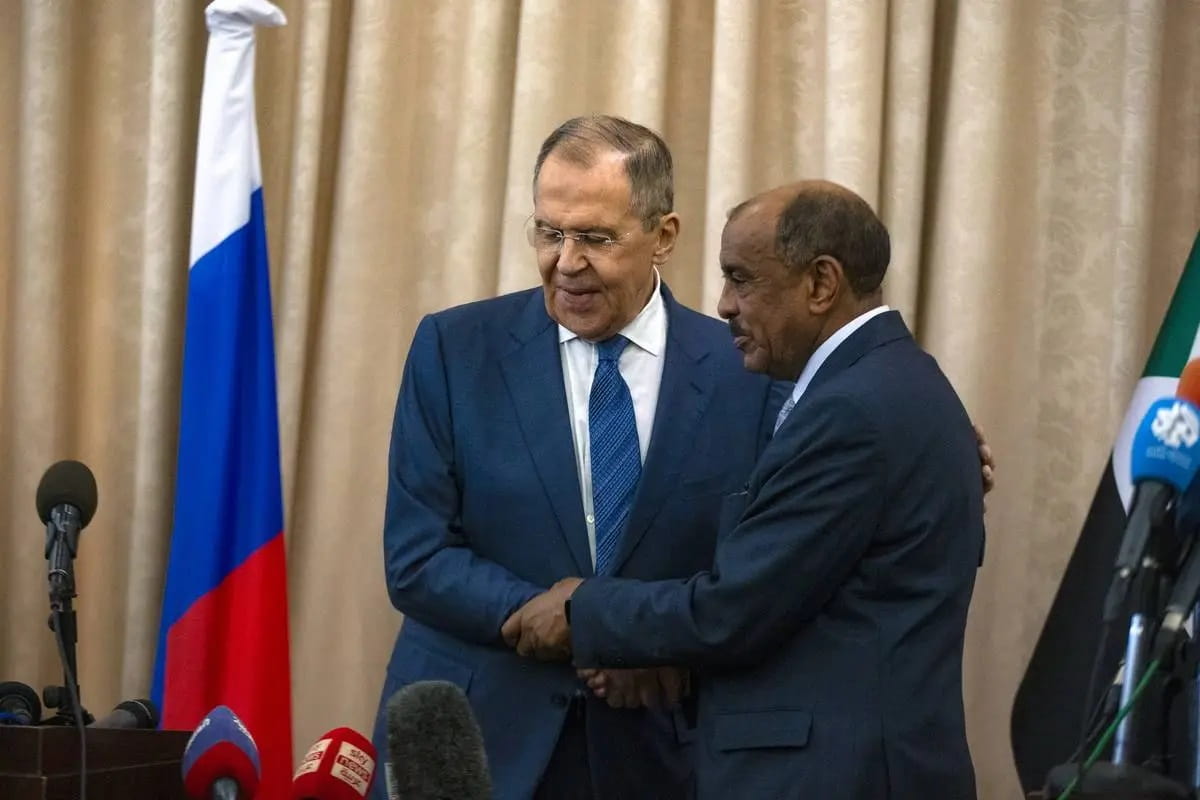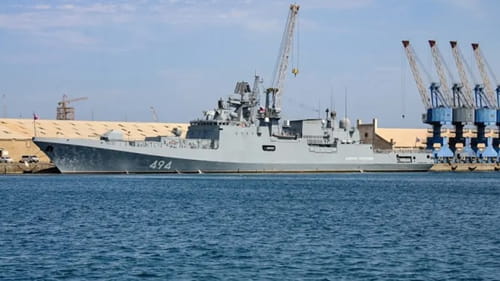
Russia’s Foreign Minister Sergei Lavrov and Sudan's Acting Foreign Minister, Ali al-Sadiq, hold a joint news conference in Khartoum, February 2023. | Mahmoud Hjaj – Anadolu Agency.
It can be said that only after the outbreak of the conflict in Ukraine did Russian politicians understand why they needed the Indian Ocean. Abstract considerations about the projection of power are discarded, Russia's new approach to the region is absolutely Mahanian: the safety of navigation in the Indian Ocean is needed in order to support the economy and feed the people. The status reason turned into an existential one. The main question now is how firmly Russia will gain an economic foothold in the region because this will determine how many resources it will be willing to devote to being present in the Indian Ocean after the end of the conflict, and in what form this presence will take place.
Introduction
The shores of Russia are washed by three oceans but the Indian is not among them. Historically, Russia expanded north and east, sometimes west but its path to the south was blocked by the Pamir, Hindu Kush and Caucasus Mountains and the ancient civilizations that lay beyond them.
This does not mean that Russia did not strive south. Peter the Great organized several land expeditions to explore the passage to India and was going to send a maritime expedition to the Indian Ocean to reach an agreement with Madagascar’s pirates.
But Peter's death put an end to his projects. Russian warships appeared in the region only in the 19th Century, after Napoleon’s defeat. These expeditions were mainly scientific in nature but a few decades later the Great Game began, and strategists in St. Petersburg began to think about creating a cruising squadron to destroy British trade in the Indian Ocean. These plans remained on paper.
Russia's return to the Indian Ocean occurred in the second half of the 20thCentury after the actual collapse of the British Empire and the beginning of the Cold War. A Soviet squadron was constantly on duty in the Indian Ocean but this region remained a secondary theater of operations: the USSR and the USA often solved the same problems there and acted together in a strategic sense, ensuring the safety of navigation, the fight against pirates, and mine-sweeping after armed conflicts.
After the end of the Cold War, Russia withdrew from the Indian Ocean. The Russian fishing fleet was privatized, partially sold off or scrapped. The same happened with the merchant navy. The new Russia has economically turned into a resource colony of the West. The new Russian leadership sharply reduced its geopolitical ambitions; the Indian Ocean was no longer included in them.
Russia’s Happy Return
In the 2000s, Russia began to look with renewed interest towards the Indian Ocean. This view was initially geopolitical: it was believed that Russia needed to increase its profile on a global scale in order to be taken into account and could maintain its status as a great power. This request existed both at the level of politicians and among people dissatisfied with the consequences of the collapse of the USSR. At the same time, the state of the economy and Armed Forces did not allow Russia to waste resources. It was necessary to justify the need for this decision for Russia to return to the Indian Ocean.
The catalyst was the campaign in Syria. Russian forces – initially extremely small – gradually increased in size and the scope of their actions expanded. This, in turn, required a permanent Russian presence in the Red Sea to cover the southern flank of Russian operations. Russia simultaneously participated in protecting shipping from Somali pirates. It did this mainly for status reasons, to demonstrate its role as a responsible great power.
Objectively, the presence of pirates rather helped the development of the Russian economy, since problems with shipping in the Red Sea increased the attractiveness of transit by land or through the Arctic seas.
These actions gave rise to the idea of creating a Russian base in the Indian Ocean. The most logical place seemed to be the Red Sea. For a number of foreign policy reasons, Sudan was chosen as a partner country, and Russia signed an agreement with it to create a logistics support point in Flamingo Bay.
This location had a number of advantages (for example, the infrastructure and proximity to Suez) and a great disadvantage: the Sudanese regime turned out to be quite unstable. The Russian base fell victim to endless squabbles between politicians who wanted, on the one hand – to get more money from Russia while on the other – not to quarrel with the Americans –relations with whom seem to have begun to normalize.
The proposed naval base was supposed to provide cover for the southern flank of the Russian operation in Syria and at the same time perform a status function, demonstrating that Russia planned to project power in warm seas. This was a clear departure from classical Mahanian concepts and meant playing with the more subtle points of the new Cold War: a conflict that did not involve the actual use of force but rather a balancing of mutual threats and an existential hybridity that linked the projection of military power to political and economic interests.
Torturous negotiations with Sudanese elites were interrupted with the start of a special Russian military operation in Ukraine. The focus of Russian politicians and military personnel has shifted to Ukraine and the Black Sea, and the Indian Ocean has dropped from the list of possible priority areas.
U-turn to Mahan
Recently, however, Russia's interest in the Indian Ocean Region has grown radically. Until the start of the operation in Ukraine, European countries remained Russia’s key partners in the purchase of its energy resources and the supply of various industrial goods. In 2021, the EU accounted for 77.3% of all Russian gas exports, 46.3% of oil, 52.4% of petroleum products, 20.5% of coal, 35.9% of all imports of goods.
In addition, Russia hoped to become a land bridge on the route from China to Europe, creating an alternative to the route through the Strait of Malacca and the Suez Canal. But the introduction of Western sanctions forced Russia to redirect its trade flows. China and India became Russia's key trading partners, and trade with the latter – due to the lack of a land route – could only be conducted through the Indian Ocean. This created a number of difficulties.
Firstly, there are security problems. Immediately after the outbreak of the conflict in Ukraine, a number of Russian ships were detained in European waters without legal grounds. This calls into question the safety of Russian shipping in the Indian Ocean, given that European warships regularly patrol the Horn of Africa.
In addition, the threat from Somali pirates and the possibility of an attack by the Houthis remain. Although Russian ships have rarely been targeted so far, this is not ruled out in the future. In the Bay of Bengal and the Arabian Sea, the Indian Navy will be able to provide protection to Russian ships, but there is no guarantee that they will be able to do this in the Gulf of Aden.
Secondly, anti-Russian sanctions create problems when Russian ships enter the ports of India and other countries in the region. It is worth remembering the episode with the tug Ursa Major: it was denied entry into the Bangladeshi ports of Chittagong and Haldia. Although there has been no news of new such denials since then, there is still a possibility that if sanctions are tightened, this problem will re-emerge.
Finally, Russia is now implementing a large-scale program to restore its fishing potential by building numerous seiners and trawlers. This means that Russian fishing fleets are likely to appear in the Indian Ocean, where they will also need protection.

Russian Navy frigate RFS Admiral Grigorovich (494), anchored in Port Sudan, February 2021. | Agence France-Presse.
Possible Solutions
The first and third problems cannot be fully resolved until the end of the Ukrainian conflict. The Russian military industry now works primarily for the frontline. Therefore, it will be unable to fully ensure Russia’s full-scale presence in the Indian Ocean. However, this presence will remain limited as Russian shipyards continue to operate and ships remain on active duty.
We can expect either a resolution of the situation around Flamingo Bay in Sudan or a transfer of the Russian naval base to another location. Eritrea looks most promising: military facilities have been preserved in the port of Massawa, the government is ready to cooperate with Russia and appears more stable than in Sudan.
In addition, there will be increased bilateral interaction, including naval exercises, between Russia and countries whose ships are present in the region (excluding unfriendly ones). After the end of the Ukrainian conflict, however, Russia will have to decide to what extent it is willing to increase its presence in the region.
If this presence is full-scale, then, given the friendly relations between Moscow and New Delhi, it will mean that Russia will be able to help India fill the power vacuum that exists in the Western Indian Ocean off the East African coast. It will be able to take on some of the tasks of combating pirates, drug traffickers and smugglers, making it unnecessary for the countries of the region to turn to Western countries and China.
The second problem can be solved by investing in the development of regional ports and building infrastructure there. If Russian ships use terminals operated by Russia-India joint ventures, it will ease concerns about sanctions. How intensive the investment process will be in the coming year will determine its continuation after the end of the conflict, when for Russia it will turn from a necessary and urgent measure into a commercial project.
Conclusion
It can be said that only after the outbreak of the conflict in Ukraine did Russian politicians understand why they needed the Indian Ocean. Abstract considerations about the projection of power are discarded, Russia's new approach to the region is absolutely Mahanian: the safety of navigation in the Indian Ocean is needed in order to support the economy and feed the people.
The status reason turned into an existential one.
The main question now is how firmly Russia will gain an economic foothold in the region because this will determine how many resources it will be willing to devote to being present in the Indian Ocean after the end of the conflict, and in what form this presence will take place.
(Exclusive to NatStrat)